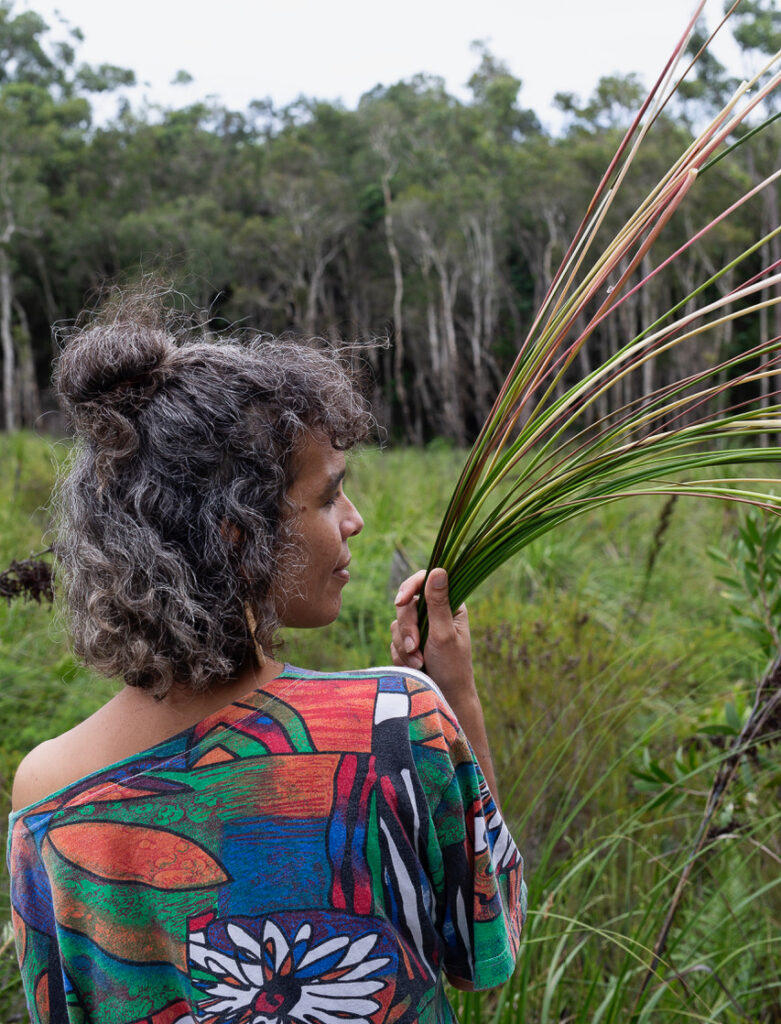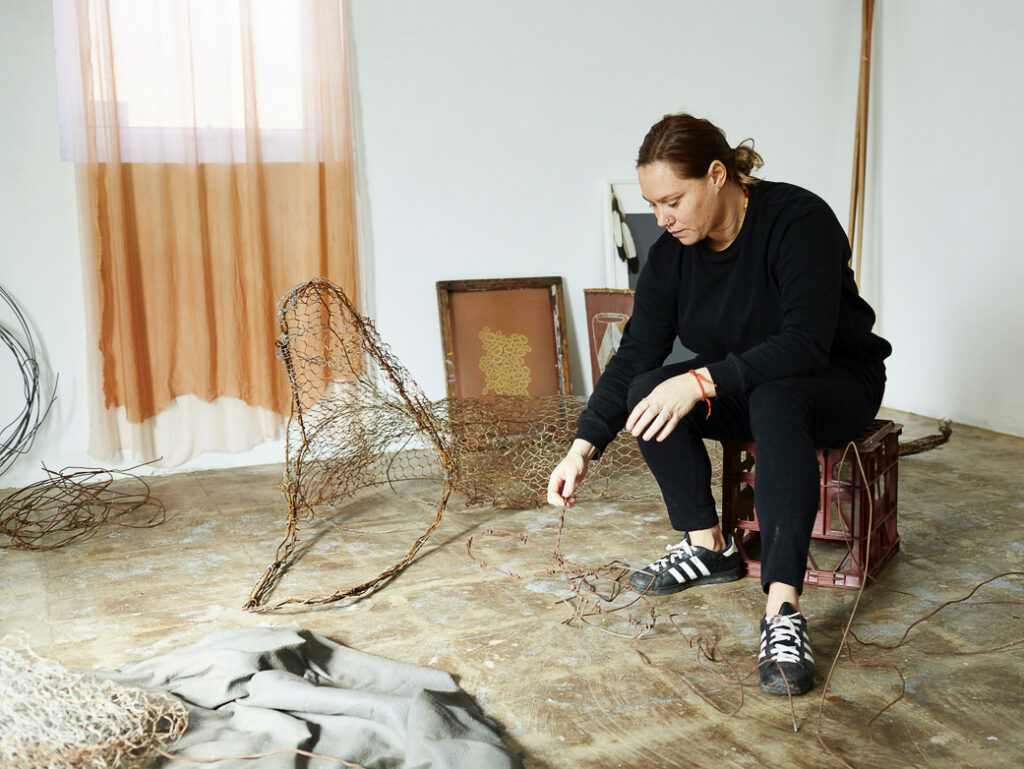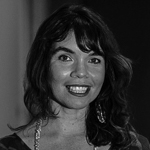
Delissa Walker with black palm fibre, Daintree rainforest. Photo: Rhett Hammerton. Image courtesy of Institute of Modern Art.
Freja Carmichael reflects on artists whose work provides a conduit for the spirit of fresh and salt water.
Seas, rivers, streams, creeks, lakes, lagoons and fresh water springs are carriers of meaning. For many Aboriginal and Torres Strait Island people, these waters are inseparable from the lands to which we belong and hold deep origins too. Waters are lived, known, named, gathered, carried, sustained, sung, danced, painted, nurtured, loved and respected. They are the rich sources of our cultural materials, and their stories are interwoven with our lives.
Like a confluence—where bodies of water meet—long water: fibre stories at the Institute of Modern Art travels across salt water and fresh water country to bring together fibre practices of Aboriginal and Torres Strait Islander artists and cultural practitioners from different generations, experiences and ancestries. The featured artists—Susan Balbunga, Mandy Batjula, Elisa Jane Carmichael, Sonja Carmichael, Fiona Elisala-Mosby, Janet Fieldhouse, Helen Ganalmirriwuy, Ruth Nalmakarra, Paula Savage, Lucy Simpson, and Delissa Walker—include community Elders, leaders, and younger artists, working in collaboration with collective and family memory or with their kin, community, or art centre to nurture, preserve, and share culture through fibre-based forms. These artists all carry a spirited attachment to water.
The places or passages traced in long water are as follows: the vital fresh water rivers of Yuwaalaraay country (North West NSW); the abundant salt water and fresh waters of Quandamooka country (Moreton Bay, South East Qld); the place where sea and tropical rainforest meet on Kuku Yalanji country (Far North Qld); the brilliant turquoise waters and clusters of islands in Torres Strait region (Far North Qld); and finally, the seas surrounding the spirited lands and waters of Yurrwi (Milingimbi Island, NT), and neighbouring homelands in far North East Arnhem Land (NT).
In curating long water, I have drawn inspiration from my family and cultural groundings. I am a Ngugi woman, belonging to one of three clan groups of Quandamooka country, also referred to as Yoolooburrabee (people of the sand and sea). Our people have a long and strong connection with the salt water and fresh water lakes, swamps, and creeks of Quandamooka country. This history is reflected in our rich fibre traditions that have arisen from our knowledge of djara (land), yarong (sand), dabiyil (water), and seasons. Using ungaire (swamp reed), our Ancestors skilfully created looped and knotted gulayi (Quandamooka women’s bags). These unique flat bags, bearing a diagonal knotted pattern, were integral to daily life, used for carrying and protecting seafood and shellfish as well as other tjinden (food) sources and important belongings. Similarly, the bark of tawalpin (cotton tree) was stripped and twisted together into string for the making of large nets used to collect fish in rhythm with the yarabin (sea) and nature’s cycles.

Elisa Jane Carmichael with ungaire, Minjerribah. Photo: Rhett Hammerton. Image courtesy of Institute of Modern Art.
A sense of place, history, and knowing is always present in First Nations fibre work, whether old or new: these meanings and associations are as embodied in the materials as they are in the processes of production. For my family of Quandamooka weavers (my mother and sister, Sonja and Elisa Jane Carmichael are featured in long water), continuing the materiality and techniques of our Ancestors and expanding on their methods are both significant expressions of salt water identity, history and experience today. Similarly, other Aboriginal and Torres Strait Islander artists and communities working in fibre mediums make their kinship with water visible by extending family or embodied practices of their cultural lineage into new forms and processes. In long water, artists embed the links between water and weaving in intricate forms and spirited installations. The exhibition shares a collection of their stories as outlined below.

Susan Balbunga with ‘Bamugora’ (in development), pandanus, Yurruwi (Milingimbi Island). Photo: Rhett Hammerton. Image courtesy of Institute of Modern Art.
Garrawurra weavers Ruth Nalmakarra, Helen Ganalmirriwuy (Liyagawumirr Garrawurra), and Mandy Batjula (Gaykamangu), have created a collection of five ochre-painted baskets, Giwiḻirr (Garrawurra dilly bags) (2020) that represent the birth of a fresh water site at Gärriyak by the Yolŋu creation beings, the Djaŋ’kawu Sisters, and the knowledge they gave to their Garrawurra people of North East Arnhem Land. Susan Bulbunga (Warrawarra) has also created work associated with the significant story of the Djaŋ’kawu Sisters and their travel pathways across salt water country. Her woven pandanus cone-shaped mat Bamugora (2020) channels her childhood memories of growing up with her family in the bush and the memories of her grandmother’s making, and ceremonial and practical use of the cone-shaped mats.

Lucy Simpson with ‘Gungandhi’ (in development), found materials. Photo: Chris Chen. Image courtesy of Institute of Modern Art.
The inter-generational collaboration budjong dabiyil (2020) by my family, Sonja and Elisa (‘Leecee’) Jane Carmichael, (Ngugi) brings together language, material culture and symbols of the sands and seas to draw connections between matrilineal ancestors and life-giving waters of our Quandamooka country. Similarly, Lucy Simpson’s (Yuwaalaraay) floating sculpture Gungandhi (2020) speaks of unbroken relationship between people and country. Her weaving transforms abandoned fencing wire and mesh gathered on her country into a large vessel inspired by Yuwaalaraay ancestral stories.
Delissa Walker (Kuku Yalanji) honours her grandmother’s legacy by continuing weaving techniques and forms that have arisen from her rainforest country. She has created a collection of Kakan (baskets) and Guppy catchers (2020) that highlight the resourceful objects of her past generations’ daily engagements with sea, river, and fresh water streams. Fiona Elisala-Mosby (Kala Kawa Ya) also draws strength and inspiration from the cultural education of her Aka (grandmother) in her series of printed panels Ngurpay (2020), meaning ‘teaching’ in her people’s Kala Kawa Ya language. In her large body of works on paper, she represents the essentiality of the pandanus plant to Torres Strait Islander cultural practices.

Janet Fieldhouse with ‘Body Scarification’. Photo: Rhett Hammerton. Image courtesy of Institute of Modern Art.
Janet Fieldhouse (Kala Lagaw Ya and Meriam Mir) expands on fibre practices, by combining the medium of clay with weaving traditions to celebrate the artistic practices, rituals, and material cultural of her Torres Strait Islander heritage. Her series of hand-built forms translate women’s stories, water navigation traditions, and her people’s land and sea relationships across time. In a similar approach, Paula Savage (Kala Lagaw Ya and Meriam Mir) explores contemporary materiality as way of sharing her observations of the sea and home islands. She hand-dyes natural raffia material to create vibrant colour palettes inspired by the life and environment of the Torres Strait Islands. The raffia is twined together into basketry forms, consisting of dense woven patterns and adorned with seeds and shells collected from the shoreline.
From Ancestral baskets and bags to contemporary manifestations of fibre traditions, the artists in long water make clear that their relationships to water are both unbreakable and complexly interwoven with all other elements that sustain life, culture, identity and spirituality. Their artworks remind us that to weave is to honour the ways of water, to care for the environment and systems that support important water sites, and to acknowledge that Aboriginal and Torres Strait Islander cultures flow from a deep and eternal source—Ancestors and country.
long water: fibre stories opens at the Institute of Modern Art, Brisbane on 05 September -19 December 2020. Visit ima.org.au/exhibitions/long-water/ for further information.
Author
 Freja Carmichael is a Ngugi independent curator, writer and arts worker, belonging to the Quandamooka people, dedicating her projects to the preservation and promotion of First Nations fibre art and collaborative curatorial approaches. She is curator of long water: fibre stories at the Institute of Modern Art.
Freja Carmichael is a Ngugi independent curator, writer and arts worker, belonging to the Quandamooka people, dedicating her projects to the preservation and promotion of First Nations fibre art and collaborative curatorial approaches. She is curator of long water: fibre stories at the Institute of Modern Art.

